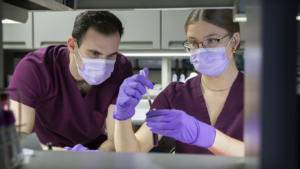Workplace safety is paramount for any business, but it becomes all the more crucial when it comes to high-risk industries, such as construction, for example. Your business must take the right steps to prevent non-fatal work-related injuries since this not only safeguards employees but also enhances productivity and reduces costs.
This is no surprise, as in the UK, data from the Labour Force Survey indicates that 561,000 workers sustained non-fatal injuries in 2022/23, and 124,000 of these led to absences of over seven days. Given that 70% of small to medium-sized businesses say absenteeism affects profitability, you can see why addressing these injuries is vital.

The most common workplace injuries
Lets’ take a look at what the most common workplace injuries are, so we know where and how we can start preventing them. The Health and Safety Executive highlights the most common non-fatal workplace injuries in 2022/23 as follows:
- Slips, trips, or falls on the same level – 32%
- Handling, lifting, or carrying – 17%
- Being struck by a moving object – 11%
- Falls from height – 8%
- Acts of violence – 8%
These incidents are not confined to high-risk industries either. They can occur in any workplace. However, sectors such as agriculture, construction, and food services report higher injury rates.
Effective measures to prevent injuries
So, what are the best ways to go about preventing these non-fatal work injuries? Here are the top measures to put in place:
Safety signage
One of the simplest, yet most effective, ways to prevent workplace injuries is through proper safety signage.
As an employer, you must provide safety signs when certain risks cannot be avoided or controlled in other ways. This could be, for example, a sign that indicates a nearby hazard or specific instruction.
Signs should be maintained regularly, placed in a correct and clear position, and use appropriate colours to indicate specific actions – red for prohibition, blue for mandatory actions, and yellow/black for warnings.
Anti-slip matting
Another way to prevent workplace injuries, given that slips, trips, and falls are among the most common workplace injuries, is to implement anti-slip solutions.
This essential step involves putting anti-slip matting, tape, and stair treads in any areas where there is a slippery surface. Proper entrance matting helps keep the working environment clean and dry, so there’s a reduced risk of slips from water or mud brought in from outside.
Zone classification
Effectively zoning your workspace, especially where there are hazardous areas, is crucial. This involves regular risk assessments to classify and manage zones where there could be risk of explosions.
In industries like warehousing, where the risk of explosive atmospheres exists, following ATEX zone classifications ensure safety and compliance.
Good housekeeping
It sounds simple, but maintaining a tidy and organised workplace can be significant in preventing many accidents.
This includes having spill-cleaning kits readily available, clearing obstacles, covering cables, signposting uneven surfaces, and using shadow boards to organise tools and equipment.
With these practices in places, you can help create a safer and more efficient work environment for your business.
Training
Continuous training is also vital in reducing workplace accidents since it gives employees the tools and knowledge to navigate the workplace as safely as possible.
Staff should be regularly trained on safety protocols, proper equipment use, and emergency procedures. Refresher courses can also help reinforce these practices and ensure that safety remains a priority.
—
Ultimately, preventing non-fatal work-related injuries is a shared responsibility between employers and employees. But in order to do this most effectively, you must implement the right safety measures, such as proper signage, anti-slip solutions, zoning, good housekeeping, and regular training.
By prioritizing safety, businesses can create a productive and secure environment, benefiting both their employees and their bottom line.




